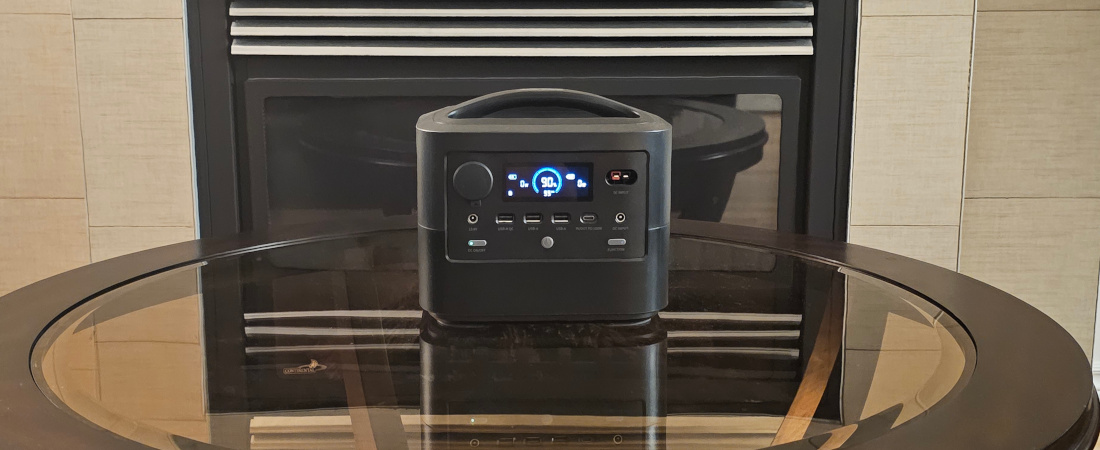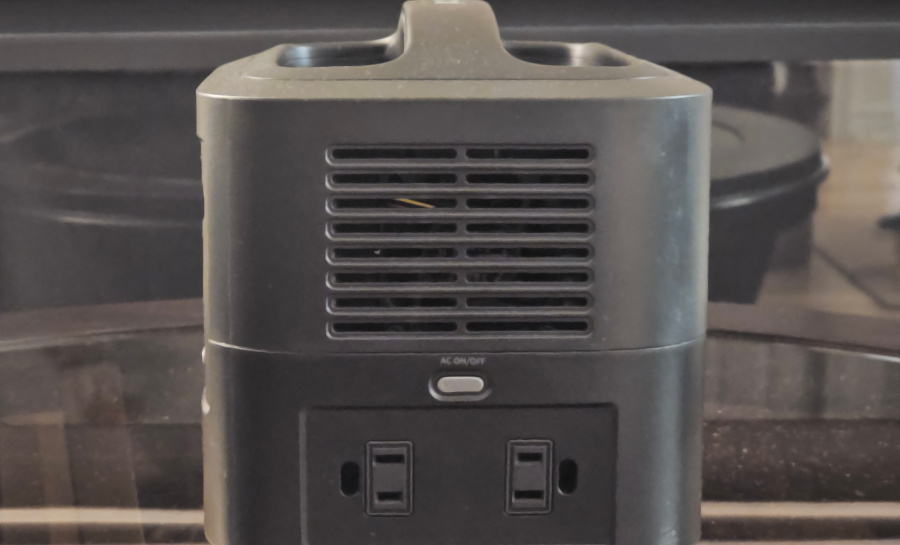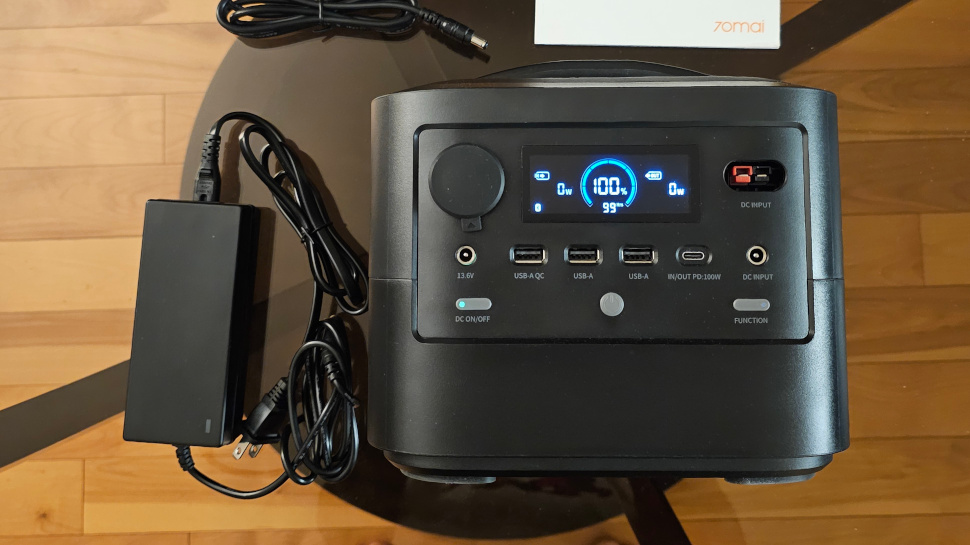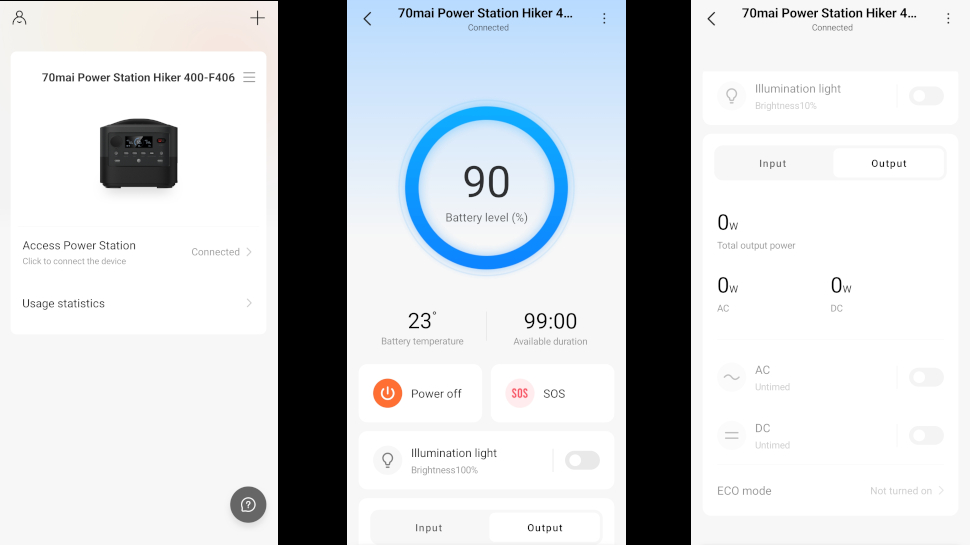
The 70mai Hiker 400 is what everybody wants in a portable power station. It is tiny, lightweight, and can easily fit in a backpack. The plastic case is tough and integrates a small handle. A single fan provides the necessary airflow for the unit, producing barely any noise during regular operation. The NCM battery is not the best available in terms of lifetime, but with a capacity of 378Wh, it has enough energy to charge a laptop over five times.
The technology behind the 400W inverter yields an efficiency of 74% and limits the amount of energy wasted as heat. A built-in Bluetooth low-energy interface controls the unit over a short distance, allowing turning on the built-in flashlight remotely, among other things. The device features four USB ports, but only one is Type-C. Two AC sockets complete the output section.
The 70mai Hiker 400 is available directly from the 70mai online store for $399, or $1.05 per Wh, a high number for an NMC-type power storage solution. It comes with a limited two-year warranty.
70mai Hiker 400:
Testing the unit consisted of an initial discharge cycle followed by a complete charge. Input power over time when charging was recorded. The unit was again discharged using an AC load at full inverter capacity. The energy provided, in Wh, when compared to the initial charge, gives an idea of the overall efficiency of the power station.

70mai Hiker 400: Design
The unit ships with a 90W power adapter, a car charger, and a user manual. A curved handle at the top makes carrying the Hiker 400 around easy but renders storing the unit more cumbersome.
Battery Chemistry: Lithium NCM
Battery capacity: 378Wh
Number of charge cycles: Over 1000
AC output power: 400W, Surge to 800W
DC output power: 254W
Number of AC outlets: 2
Number of DC outlets: 5
AC inverter efficiency: 74%
Number of power inputs: 3
Fastest charge time: 4 hours
Additional features: Bluetooth LE, Flashlight, ECO mode
Weight: 3.9kg
Volume: 7.7L
Price: $399
A curved top also means losing the ability to place items like smartphones on a flat surface. The unit is well constructed with quality material. Four rubber pads on the bottom prevent the station from moving when cables are connected. The unit measures 22cm x 17.7cm x 19.7cm for a weight of 3.9kg.
The front panel holds the user interface. A high-contrast segmented LCD shows easy-to-understand information while reducing power consumption. The power gauge is displayed centrally. Input and output power and other measurements have a reasonable one-second refresh rate. Icons for Bluetooth, Eco-mode, and timer indicate what features are enabled.
Five push buttons control the unit. The Power and Function buttons are dual-purpose. A long press on Power will turn the unit on or off, while a short press on Function enables the Eco-mode. A long press on Function places the unit in Bluetooth pairing. The remaining three buttons activate electrical sockets or the flashlight. All push buttons light up when active.
The Hiker 400 supports three charging modes totaling 120W of input power. The most convenient charging method remains through the USB Type-C socket, but it takes four hours to complete. The Anderson and 5525 DC inputs both support 12V or 24V, which makes it easy to use a 100W solar panel. The supplied 19V 90W power adapter will take the longest time to charge.
The station provides four USB sockets. A single Type-C socket supports the power distribution mode of up to 100W. In addition, three USB-A sockets offer 5V for a maximum power of 18W. The other DC outputs are a 5521 and a carport, supplying the same regulated 13.6V supply at 10A. Two 120V AC outputs supply 400W under regular operation and can boost to 800W for short durations.

70mai Hiker 400: In use
The 70mai mobile app, available for Android and Apple phones, enables the station's remote control but requires registration. Installation of the Hiker 400 is easy thanks to clear on-screen instructions. Two icons representing the Bluetooth and smartphone modes appear on the LCD, indicating that the app is connected to the station. Turning off the station does not disconnect the Bluetooth.
With features such as an Economic mode and a power passthrough, the Hiker 400 makes the most out of its small footprint. In the Economic mode or Eco, the station turns off unused outputs after a predefined time. The power passthrough uses the DC input to power devices connected to the station, bypassing the Lithium battery and reducing its wear.
The power station was tested using programmable AC and DC loads to get its overall efficiency. Ideally, this should be 100%, but due to the heating of internal parts and using an active cooler, this number oscillates around 80%. The Hiker 400 earns a respectable 85% when using the DC output, which decreases to 75% in AC mode. The difference is explained by having the fan operating when using the AC inverter. The noise level of the fan at one meter is around 45 dB.

70mai Hiker 400: The competition
Portable power stations capable of less than 1000W used to be rare, their primary purpose being as an emergency power source on the road or at home. The Hiker 400 is ideal for this situation with its small volume and lightweight. The battery chemistry works down to -10 degrees Celsius, making it hard to use on cold winter days.
The Bluetti EB3A is the power station to beat with a price similar to the Hiker 400. Equipped with Bluetooth, it lacks an Anderson input, which limits the type of solar panel it can work with, and more importantly, the battery is limited to 268Wh.
70mai Hiker 400: Final verdict
The Hiker 400 provides good battery capacity and inverter power in a small volume. The unit's versatility is on full display thanks to the Bluetooth low-energy connection. It is an excellent feature since the device rarely loses connection with a paired smartphone. The well-designed mobile app also stands out with no bugged functionality. At 75% in AC mode, the system's overall efficiency is what one can expect at this price point.
The battery chemistry could be better, but an NMC type still provides at least two years of full capacity, even with daily charge and discharge cycles. Although we liked the passthrough feature, it could have been better as the power is limited to 120W. Having an external power adapter is also something competition tries to avoid as it means an extra item to carry around.







